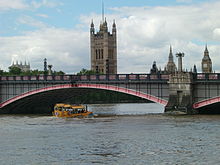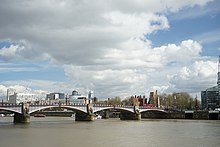Lambeth Bridge
[2] Doubts about its safety, coupled with its awkwardly steep approaches deterring horse-drawn traffic, meant it soon became used almost solely as a pedestrian crossing.
It ceased to be a toll bridge in 1879 when the Metropolitan Board of Works assumed responsibility for its upkeep — it was by then severely corroded, and by 1910 it was closed to vehicular traffic.
Following the flood the Chelsea Embankment was rebuilt and raised, resulting in some minor redesign of the approaches, and creating the open space to the north of Lambeth Bridge now known as Victoria Tower Gardens South.
The current structure, a five-span steel arch, designed by engineer Sir George Humphreys and architects Sir Reginald Blomfield and G. Topham Forrest,[3] was built by Dorman Long[4] and opened on 19 July 1932 by King George V. It formerly carried four lanes of road traffic (now reduced to three lanes, one of which is a buses-only lane flowing eastbound) from a roundabout junction by the Lambeth Palace northwards to another roundabout, where the Millbank road meets Horseferry Road .
[6] The bridge was declared a Grade II listed structure in 2008, providing protection to preserve its special character from unsympathetic development.





